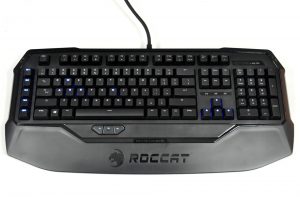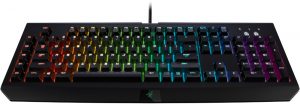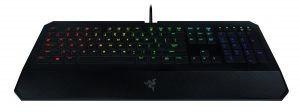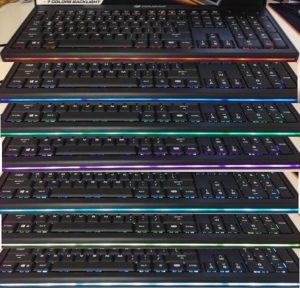Someone needs to come clean with the gaming community and remind them what they actually want when it comes to gaming peripherals. Why on earth would anyone want to game on a keyboard that’s just as noisy as the musical variant, being distracted by the laser light show commencing under their noise whilst spending over a £100 for the honour.
I highlight the incessant need of mechanical ‘gaming’ keyboards that have been on the market for the last 8 or so years, replicating the era of with clunky keypresses of yellowing IBM keyboards.
For those still unaware of the difference of mechanical and membrane keyboards, mechanical keyboards have each key fitted with a spring and a metal switch that depresses and clicks when activated, whilst a membrane keyboard is a long rubber mat of electrical connectors that activate when the key above is depressed down above it.
I learnt to touch type from a very early age, probably the only actual talent I have to showcase, and able to type on a keyboard without looking at over 80 words a minute. When it comes to typing, I know exactly on a membrane keyboard when I’ve depressed the key far enough down to gain a response from the computer, thus resulting in a letter appearing on the screen. But for many gamers out there, this seems to be a struggle and require further feedback in the form of their key press to have both an audible and tactile click underneath their fingertips. Yet when your typing at 80 words per minute, there is nothing more annoying than having a constant irritable clicking noise whilst trying to concentrate on your work. I’m not working in a busy newspaper editing room, I’m just relaxing in my quiet bedroom, with some tunes quietly playing in the background.
When it comes to gaming, you only want keys that depress softly, just like the buttons on a controller. You want to glide your thumb along the buttons, and not get caught up on small clicks, wondering if that was the vibration feedback telling you if you’d been shot. Not to mention watching twitch streamers that you can’t hear over the mechanical key presses of their gameplay. Essentially, membrane keyboards are the way to go for work and for gaming, but it was a lesson even I was to learn after getting burnt.
When I first purchased my gaming computer, mechanical keyboards had been on the market for a while with cherry mx keys being on everyone’s lips. At the time, I thought of it as a fad that would pass, just like any fashionable item comes and goes, after a period of popularity. I’d not used a mechanical keyboard myself at this point, and not wanting to take the risk, decided to stick with the tried and tested membrane keyboard, for those soft, comfortable, rolling key presses. I bought into the Razer ‘gaming’ image and bought the Razer Lycosa Mirror keyboard and Razer Imperator mouse.

Razer Lycosa Mirror
The Lycosa keyboard, made entirely out of a shiny semi-reflective black plastic, is a slim membrane keyboard with blue backlighting. The backlight was a great feature, allowing me to see the keys at night in the dark, but only had 3 settings of brightness and nothing more. The keyboard had some touch sensitive media keys which were nice to use and now standard for any keyboard unless you want to have to come out of your game every time that you want to alter the volume. The keyboard on the whole, was fine to use, with my only issue being that the keys were made of a glossy plastic, that became slippery when grease procured on them, which would happen over the course of a week, resulting in constant cleanings, but other than that, the travel and feel of the keys were perfect and allowed for smooth typing and immersive gaming.
After 3 years of use, this keyboard got caught by the door in a heated online match. So I was back on the prowl for a new ‘gaming’ keyboard. With the advancements in mechanical keyboards and its technology, I thought that it was now the time to buy into becoming at one with my computer via a mechanical keyboard. I trawled through the Internet for days, trying to find a keyboard within a budget of £80 that had rave reviews. I came across the Roccat Ryos MX keyboard, that was a few years old but seemed to suit my requirements. So it arrived the next day from Amazon, and boy was it a let down. Straight away, the feel of the keys felt tacky and the clicking mechanical components were absolutely disgusting to activate. How on earth was I to game in the middle of the night if noisy key clicks would ruin any chance of immersion into the game. The unique macro keys located under the space bar to be used by the thumb were difficult to use requiring quite some force to activate. Having purchased this via Amazon, I was able to send this straight back with no questions asked.

Roccat Ryos MX

Razer BlackWidow
I next decided on the Razer BlackWidow Chroma keyboard, with rainbow RGB that was now costing me £130, but what the hell, surely I was future proofing myself for many years to come with a fashionable mechanical keyboard that would be the talk of my flat parties. Yet once again, I was heavily disappointed on the feel of the tackiness of the keys, especially considering the amount of money I had dropped on this. Again, back to Amazon it went.
At this point, I was struggling to grasp why these expensive keyboards just felt tacky and why they didn’t appeal to the gamer in me. I wanted to have the seamless experience I’d had with my Lycosa, which I now realised I had taken for granted. I wanted to recapture that experience, but Lycosas were no longer manufactured, and used models on the Internet (uuurggh, there’s nothing more gross than a used keyboard) were over £70! But I was finally able to identify what it exactly was that I wanted out of keyboard. It had to have slim keys rather than the tall ones that wobbled around under resting fingers, and most importantly, it had to have a membrane activation system.

Razer Deathstalker

Cougar 200K
After much more research, it became a tossup between the ‘trusted’ brand Razer with its RGB Razer Deathstalker offering at £70 and the Cougar 200K at £20. The problem with the Razer keyboard was that it had laptop chiclet keys which looked far too spaced out, so I opted for the Cougar 200K. When it finally arrived, I was finally happy.
I’ve had this keyboard for over 6 months now, and am still very happy with it. This keyboard uses a scissor switch mechanism, which is membrane based and essentially similar to the keys on laptops. These low lying keys allow for my finger to glide to the next key whilst still holding the current key depressed. This can’t be done with regular keys as when depressed, sliding your finger across to the next one results in just hitting the outside of the key. The only way to hit that key properly is to lift your finger entirely off the key you were just depressing to be able to move across to the next key. In gaming, when you want to be able to go from walking forward to strafing sideways seamlessly, low lying keys is a must. Plus, their activation points are much lower, meaning that keys can activate quicker after being depressed and makes your gaming more responsive. For mechanical keyboard manufacturers, they’ve now ‘developed’ this into their new series of switches, adding an extra £40 onto the price tag for a feature that has existed for years.
The next feature that I actually do love about this keyboard is its style. The keyboard exterior is hard plastic with an aluminium brush finish, and the keys have a nice smooth matte feel. The keyboard has a good heavy weight to it, and sits nicely on the desk with plenty of rubber feet spread out along the bottom. The angled edges make this keyboard look extremely well crafted and high value, which I must reiterate, was only £20! It’s able to do this by not including audio hardware to pass through headphones or a USB port (which is irrelevant with a front case bus) and by not having additional macro keys like many ‘gaming’ keyboards have, which in my opinion, are not required when there is already 120 keys readily available to assign macros to. Also, there is no included wrist rest, which on most keyboards is nothing more than a chunk of hard plastic taking up valuable space real estate on my glass desk.
The colour palette of the keyboard is great too, with the grey exterior, black keys and orange backlight. The keyboard is capable of 7 colours overall; orange, blue, green, purple, aqua, yellow, white with brightness settings and a breathing mode. But the orange and black style just looks awesome, and has spread to the rest of my gaming setup, having now replaced my blue LED case fans with orange ones, the Windows desktop theme has been made to match and I’ve also got a black and orange desk chair.

Cougar 200K Colours
I’m not sure why anyone would really want an RGB keyboard capable of performing an array of light shows, when if I want to look at something colourful and interactive, I can just look up at the monitor with millions of more pixels and that’s the thing, when I’m focusing on the monitor in front of me, I don’t want to be distracted by flickering lights at the edge of my peripheral vision, even a gentle fade of brightness is enough to catch my attention. An ambient glow of orange on the otherhand is perfectly fine for not drawing my attention whilst providing me with the required information of keyboard layout and hand placement when I do have a quick glance down.
I am absolutely pleased with my Cougar 200K and will ensure to take much better care of it than I did with the Lycosa, but having said that, if anything was to ever happen to it, well atleast it would only cost me £20 to replace it, and not £120 for an underperforming mechanical keyboard that the gaming community has somehow latched onto.








